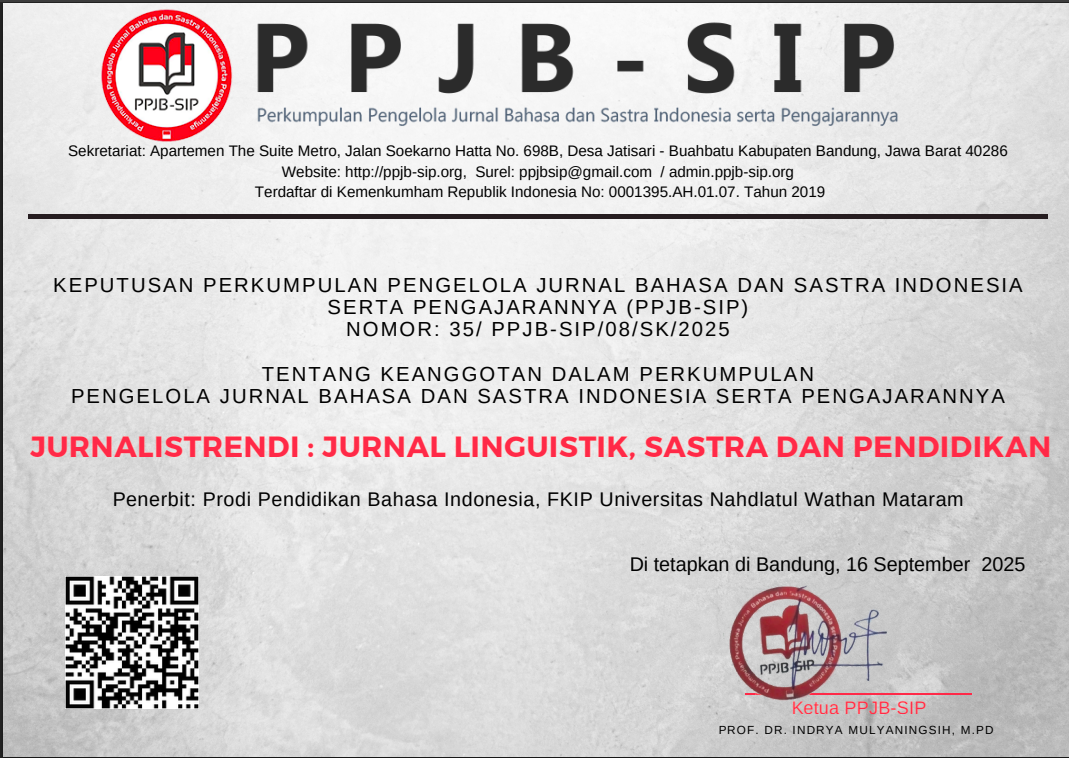Verba Denominal dalam Buku Sebuah Seni untuk Bersikap Bodo Amat Karya Mark Manson
Abstract
This study aims to describe the form of denominational verbs, the meaning of affixes forming denominational verbs, and the function of denominational verbs in the book Sebuah Seni untuk Bersikap Bodo Amat. This study used qualitative descriptive method. Data were analyzed using intranlingual padan method. The results of the study found three affixes that form the denominational verbs in the book an art to be stupid Amat namely, prefix, suffix and confix. The meaning of the denominational verb-forming affixes in the book an art to be stupid is, that is, the prefix {məŋ-} means `to do`, `to go`, and 'to resemble'. The prefixes {bər-} mean `produce`, ‘have`, and `towards`. The prefixes {di-} mean 'declare`and 'specify'. The prefix {tər-} means 'accidental`, and`circumstance'. The prefix {pər-} means 'to make'. The prefix {sə-} expresses the meaning of ' one`, and `all`. The suffix {-an} Means 'act on a basic form'. Konfix {kə-[an]} means to state `matter in its basic form `and, to state` place `or`region'. Konfix {pər-[an]} Means 'thing `or` result`,` place`,` Region`, and`variety'. Konfiks {pəŋ-[an]} means 'the thing of doing an act in a word that is in line`, states the meaning of` the result of doing an act in a word that is in line`, states` the tool used to do an act in a word that is in line`, and states`the place of doing an act that is in a word that is in line'. Konfix {bər-[an]} means 'mutual'. Konfiks {məŋ-[an]} means ' to do`. And konfix {məŋ-[i]} means 'to do'. there are three functions of denominational verbs syntactically in the book an art to be stupid is divided into two categories of verbs that transitive verbs have functions as subject, object, predicate, description and complement. And the nontransitive verb has the function of predicate, adverb and complement.
Downloads
References
Burhanuddin , Mahsun, Sukri, Mahyuni dan Saharuddin. 2020. Satuan Lingual {ka-} dalam Bahasa Sumbawa Dialek Jereweh. 14 (2): hal 315-328.
Cahyo Hasanudin. 2018. Kajian Sintaksis pada Novel Sang Pencuri Warna Karya Yersita. Jurnal Pendidikan Edutama. 5 (2): Hal. 2339-2258.
Chaer, Abdul. 2015. Morfologi Bahasa Indonesia (Pendekatan Proses). Jakarta : Rineka Cipta.
Eric Mathieu. 2013. Verbs in Ojibwe. International Journal of American Linguistics. 79 (1), 97-193.
Herawati, Nanik, Rustono dan Soepomo Poedjosoedarmo. 2016. Afiks-Afiks Pembentuk Verba Denominal dalam Bahasa Jawa. Prasasti: Jurnal of Linguistic. 1 (2): Hal. 325-335.
Mahsun. 2017. Metode Penelitian Bahasa. Depok : Rajawali Pres.
Mustikasari, Galuh, Ninik Pratiwi, dan Bakdal Ginanjar. 2022. Derivasi Verba Denomina Bahasa Indonesia Pada Website Berita Online (Kajian Morfologi). Fon : Jurnal Pendidikan Bahasa dan Sastra Indonesia. 18 (2): 621-271.
Nurina Ika Sujarwanti dan Mukhlish. 2016. Verba Denominal Dalam Bahasa Indonesia. Caraka. 2 (2): 57-71.
Ramlan, M. 2009. Morfologi Suatu Tinjauan Deskriptif. Yogyakarta : Karyono.
Sukri, Sri Bagus, Mohammad Asyihar, dan Lalu Ali Wardana. 2022. Morfologi:Kajian Antar Bentuk dan Makna. Mataram: Pustaka Bangsa.
Verhaar, J.W.M. 2016. Asas-asas Linguistik Umum. Yogyakarta: Gajah Mada University Press.
Verhaar, J.W.M. 2001. Asas-asas Linguistik Umum. Yogyakarta: Gajah Mada University Press.
Trisnawati, A.A.A. 2015. Nomina Bahasa Bali Dalam Novel Tresnane Lebur Ajur Satonden Kembang : Kajian Tipologi Sintaksis. Denpasar: Program Pascasarjana Universitas Udayana.

.jpg)





